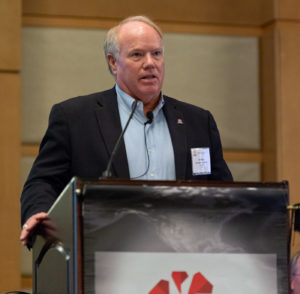Having an emergency response plan can save a company in case of well blowout
By Emily Lincke, Contributor
Developing and implementing an emergency response plan (ERP) is one of the most critical actions that an operator can take in order to save money and lives and protect the environment in case of a well control incident. Speaking at the 2019 IADC Well Control Conference of the Americas in Galveston, Texas, on 28 August, Bill Mahler, Executive Vice President of Wild Well Control, provided an overview of ERPs and key considerations when developing these plans. Having such a plan can result in preparedness, and it can make the difference between effectively navigating an emergency and having an incident that bankrupts the company.
First, Mr Mahler emphasized that an ERP is not meant be placed “behind the drilling manager on a bookshelf.” The plan needs to be updated and reviewed as needed, and wellsite crews need to undertake drills and exercises periodically. “Going through a training exercise for two hours after you get an emergency response plan and not doing anything more is just half the battle,” he said. “The other half is going and actually doing a drill or exercise where you can identify some of the problem areas.”

One major mistake that many operators make, according to Mr Mahler, is not reaching out to a well control company right away when an incident occurs. The operator may assume they have control of the situation, but seeking outside help is a safer approach and should be done before the situation escalates. “We may be able to help you over the phone call and just try to give you a little bit more direction, a little bit of confidence in what you are doing.”
In the event of a well control event, the first 15 minutes is typically going to be chaos. Some key considerations for this time should be: what to do if the driller can’t be located; which hospital should injured employees be taken to, and should we try to go back and shut the rams if we’re not sure whether they were shut?
Media will typically arrive on the scene soon, especially on North America land where drilling operations frequently take place in populated areas. Who will talk to them? Mr Mahler said that he highly encourages operators – especially small independents that don’t have an in-house media department – to hire a third party to interface with the news media. “Somebody needs to talk to the media; otherwise the rumors start, the social media starts, and it can bankrupt the company very quickly.”
Other examples of considerations include: Should homes within a half-mile be evacuated? Should we allow the volunteer fire department to get near the blowout and spray water?
Having an ERP in place would provide essential information in these first hours of chaos. “It’s a document that you can refer to back and recognize what you might need to be done,” Mr Mahler said. Importantly, it outlines a response structure that establishes lines of authority and assigns responsibilities.
Even in an emergency situation, permits, such as for pulling water from a nearby river, can take days to obtain. Other issues, such filing insurance claims and designating people to meet with the local community at regular intervals, also must be considered. “Having an effective response is really important,” Mr Mahler said. “It’s going to protect the safety of all the personnel, the location and the company’s assets.”




